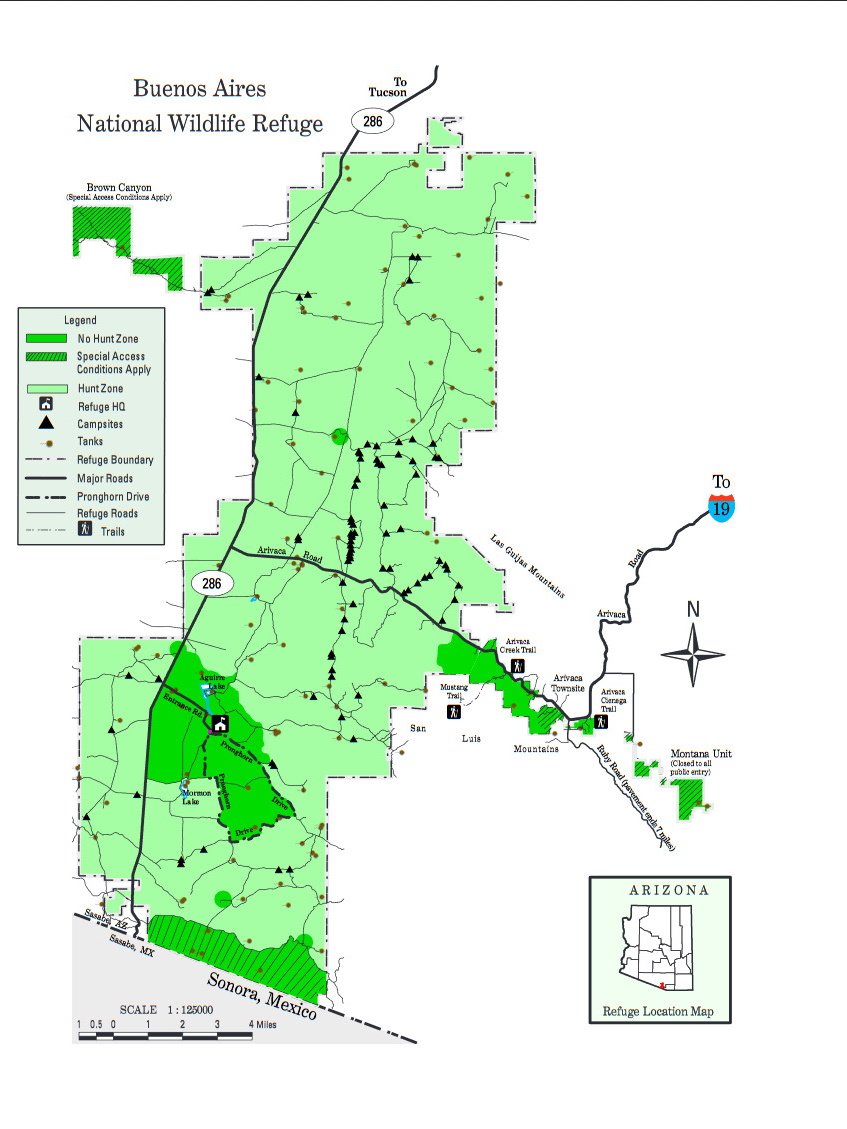Buenos Aires NWR--Headquarters Area
Buenos Aires NWR--Headquarters Area
Sasabe, Arizona 85633
Buenos Aires National Wildlife Refuge Official WebsiteBuenos Aires National Wildlife Refuge map
Buenos Aires National Wildlife Refuge Trails
Tips for Birding
The Headquarters area is one of ten location-specific hotspots within Buenos Aires National Wildlife Refuge. Two of these other discrete hotspots are within half a mile of the Headquarters hotspot. If you are submitting a single eBird list including observations both within and outside the rather small headquarters area, such as birds along the first two miles of the Refuge entrance road from AZ-286, use the greater Refuge hotspot .
Although Masked Bobwhite pens are located within the Headquarters hotspot, remember that eBird lists should not include caged birds.
Birders may find identification challenges in the presence of both Mallard and Mexican Duck, both Western and Chihuahuan Meadowlark, as well as both Blue-gray and Black-tailed Gnatcatcher.
Birds of Interest
Yellow-billed Cuckoo, officially threatened throughout the western US, have been recorded Aug-Sep.
Among USFWS-designated Birds of Conservation Concern for the Sierra Madre Occidental region, Sonoran Desert region, and Continental US, the following species have been listed multiple times for this hotspot over the recent 5-year period 2019-2023: Calliope Hummingbird (Aug), Rufous Hummingbird (Feb-Apr and Aug-Oct), Gila Woodpecker (Aug-Apr), Gilded Flicker (Jul-Apr), Verdin (all year), Curve-billed Thrasher (all year), Phainopepla (all year), Lawrence’s Goldfinch (Dec-Mar), Rufous-winged Sparrow (Aug-Mar), Prairie Warbler (Oct-Dec), Black-throated Gray Warbler (Sep-Oct), Pyrrhuloxia (all year), and Varied Bunting (Jun-Sep).
Bell’s Vireo, a threatened species in New Mexico, with an endangered subspecies in California, is observed Apr-Sep.
About this Location
Brochures and restrooms are available here from sunrise to sunset. Feeders at the headquarters attract some common southwestern birds, and pens near the Visitor Center provide a look at endangered Masked Bobwhite. A grassland exhibit will help you identify over 20 species of grasses.
From the west, take AZ-286 to milepost 7, then turn east onto the Refuge entrance road. From the east, take the Amado/Arivaca exit west off I-19, turn right at the T, and then left at the Cow Palace onto Arivaca Road. Proceed west and southwest 23 miles to Arivaca, then continue another 12 miles northwest to AZ-286, turning left at milepost 7 onto the Refuge entrance road.
The headquarters is about 2.5 miles from AZ-286 .
About Buenos Aires National Wildlife Refuge
See all hotspots at Buenos Aires National Wildlife Refuge
Located in southern Arizona, Buenos Aires National Wildlife Refuge was established for the reintroduction of masked bobwhite quail and to restore the natural landscapes and native wildlife that depend upon it.
Spanning the 117,464-acre refuge are several distinct groups of plants and animals that are dependent on each other, also known as biotic communities. Visitors will enjoy the semi-desert grasslands that blend into the cottonwoods and willow that line river banks and wetlands within the refuge. Settled in amongst the grasslands and wetlands is a beautiful sycamore-shaded canyon of extraordinary diversity. Brown Canyon is home to 200-million-year-old volcanic rocks that support a distinct variety of plants and animals that have evolved within this amazing sky island ecosystem.
Established in 1985, the refuge was purchased under the authority of the Endangered Species Act. Open to the public, visitors can enjoy wildlife watching and photography, hunting, fishing, wildlife photography, and special wildlife-related events. It is one of more than 550 refuges that comprise the National Wildlife Refuge System, a national network of public lands and waters set aside for the benefit of wildlife and you!
Notable Trails
The Ranch Loop Trail, which takes you by the bobwhite pens, is located within the Headquarters hotspot, as is the Manager's Hill picnic area.
Features
Restrooms on site
Entrance fee
Content from Buenos Aires National Wildlife Refuge Official Website, Buenos Aires National Wildlife Refuge brochure, and John Montgomery
Last updated January 6, 2024
